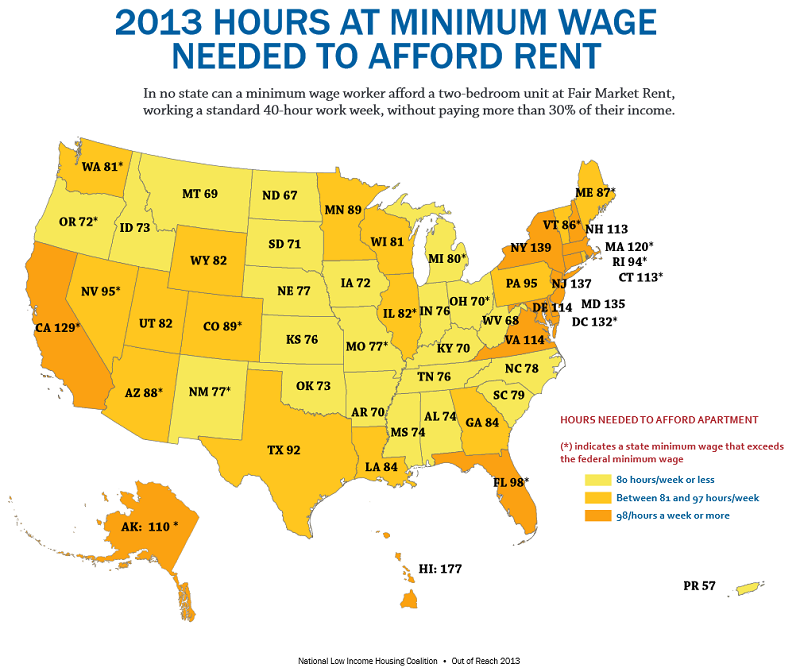Continues from previous page.

2013 hours at minimum wage or state minimum wage needed to afford rent. There is not a SINGLE state in the U.S. where workers can afford a two bedroom apartment on a single minimum wage income. Infographic from the National Low Income Housing Coalition . (* indicates states with a minimum wage higher than the federal minimum wage)
By the numbers: 12 facts about the minimum wage.
Here are some surprising facts about how our flat-lining federal minimum wage has eroded America’s middle class, and failed to keep pace with our workers’ productivity over the past 40 years:
- $7.25: The U.S. minimum hourly wage lags way behind the majority of developed nations, including Canada ($9.75), France ($12.09), and the UK ($9.83). Furthermore, Australia recently raised their minimum wage to $16.88 per hour . At least we can take dubious pride in paying our workers more than they do in Greece and Spain. NOTE: Numbers can vary based on international exchange rates.
- $2.00: The federal minimum wage is worth $2.00 less (in modern dollars) per hour than it was in 1968, according to a study from the Economic Policy Institute .
$10.52: Today’s hourly federal minimum wage if it had kept up with the rate of inflation since 1978, according to the CEPR . - $21.72: Today’s hourly federal minimum wage if it had kept up with worker’s rate of productivity since 1978, according to the CEPR .
- $725%: Increase in CEO pay since 1978, according to the CEPR . To keep up, Congress would have to raise the federal minimum wage to a whopping $71.05 per hour! ($2.65 per hour in 1978 adjusted for inflation at $9.80 per hour in 2013 dollars, multiplied by the 725% pay increase for CEOs, which is also indexed for inflation)
- 2009: The last time Congress raised the minimum wage. Coincidentally, the GOP took over Congress in 2010.
- 67: Number of hours a minimum wage worker needs to clock in to afford rent on a two bedroom apartment in North Dakota — the lowest rent state in the nation. A 40-hour week at minimum wage won’t cover on a two bedroom apartmentany where in the U.S., according to the the National Low Income Housing Coalition .
- 46%: Growth in American workers’ productivity between 1973 and 2007 (as measured by the GDP per household) since 1973, according to the economist, Paul Krugman . In 2013 alone, the BLS reported a 2.3% increase in U.S. workers’ productivity.
- 15%: The meager growth in American workers’ median income between 1973 and 2007, according to Paul Krugman .
- 1.5 million: Number of workers earning minimum wage, according to a Moyers & Company report .
- 2 million: Number of worker s earning even less than minimum wage, according to the above-referenced report. TheFair Labor and Standards Act (FLSA) doesn’t cover farm workers, Good Will’s employees , interns, or tipped employees like restaurant workers.
- 80: Percent of Americans who support raising the minimum wage to $10.10 per hour, and indexing it to the cost of living, as measured by the Consumer Price Index (CPI). According to a national survey , 80 percent of Americans (92 percent of Democrats, 62 percent of Republicans and 80 percent of Independents)
- 12: States in the U.S. — including New York, California, Arizona, Colorado, Florida, Missouri, Montana, Ohio, Oregon, Rhode Island, Vermont, and Washington — that have either raised their minimum wages in 2013, or passed laws to raise them in the near future.
These numbers show that America’s way overdue for a raise. If American workers and the middle class hope to achieve upward mobility — or even keep what little they still have — we need to drastically increase the federal minimum wage.
Featured image: Infographic by Elisabeth Parker. A version of this post originally appeared in Addicting Info.

